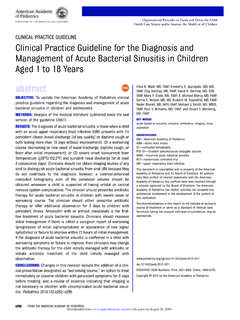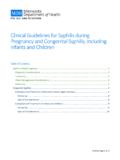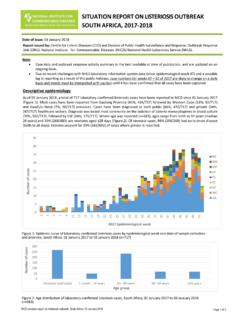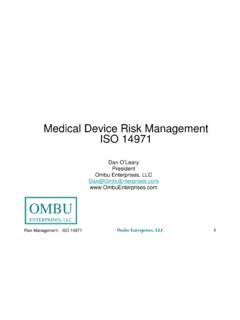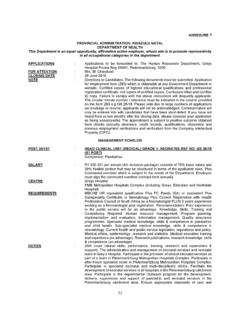Transcription of Antibiotic Use for Sepsis in Neonates and Children: …
1 1 Antibiotic Use for Sepsis in Neonates and children : 2016 evidence Update Aline Fuchsa, Julia Bielickia,b, Shrey Mathurb, Mike Sharlandb, Johannes N. Van Den Ankera,c a Paediatric Pharmacology and Pharmacometrics, University children 's Hospital Basel, Basel, Switzerland b Paediatric Infectious Disease Research Group, Institute for Infection and Immunity, St George's University of London, London, United Kingdom c Division of Clinical Pharmacology, children s National Health System, Washington, DC, USA WHO-Reviews 2 TABLE OF CONTENTS 1. INTRODUCTION .. 3 Aims .. 3 Background .. 3 Definition and diagnosis .. 3 Neonatal Sepsis .. 3 Paediatric Sepsis .. 4 Community versus hospital acquired Sepsis .. 5 Microbiology .. 5 Burden of Sepsis .. 5 Current WHO guidelines .. 7 Trial design.
2 8 2. METHODS .. 9 3. RESULTS .. 10 Synopsis of review results .. 10 evidence for currently recommended penicillin, gentamicin and ceftriaxone .. 10 Data on antimicrobial resistance .. 13 evidence for alternative regimen .. 13 Alternative and new drugs not included in clinical trials .. 14 Synopsis of international guidelines .. 15 4. SAFETY 20 5. DOSING CONSIDERATIONS .. 21 6. COST PER TREATMENT COURSE .. 24 7. OTHER INTERVENTIONS .. 25 8. ONGOING CLINICAL TRIALS .. 25 9. DISCUSSION & RESEARCH OUTLOOK .. 26 3 1. INTRODUCTION Aims Sepsis remains a leading cause of mortality and morbidity, especially during the first five days of life and in low and middle-income countries (LMIC) [1]. Hospital infection also remains a major cause of mortality in children despite progress encountered in the last decades.
3 WHO recommends ampicillin (or penicillin; cloxacillin if staphylococcal infection is suspected) plus gentamicin for empiric treatment of Neonates with suspected clinical Sepsis ; when referral is not possible, once daily gentamicin plus oral amoxicillin may be used. It is known, however, that in many countries, agents with a broader spectrum, such as third-generation cephalosporins, are commonly used to treat neonatal and infant Sepsis [2] Against this background, concerns are increasing regarding bacterial pathogens with reduced susceptibility to empiric medication with variations both between and within LMIC [3]. The WHO seeks to provide a paediatric perspective on antibiotics to be included on the list of essential medicines, which is currently in the process of being updated.
4 The potential need to revise the existing WHO guidelines based on new antimicrobial resistance (AMR) data or evidence relating to drug safety in Neonates and children must be evaluated. For this purpose, a number of reviews have been commissioned to address these aspects. This review collates evidence to support current empiric Antibiotic recommendations for suspected or confirmed Sepsis in Neonates and children according to the most recent ( year 2012) relevant studies. Background Definition and diagnosis Neonatal Sepsis An accepted definition of Sepsis in Neonates is lacking. According to the report on the expert meeting on neonatal and paediatric Sepsis of EMA (2010) [4], neonatal Sepsis can be defined by the presence of at least two clinical symptoms and at least two laboratory signs in the presence of or as a result of suspected or proven infection (positive culture, microscopy or polymerase chain reaction) (Table 1): Clinical signs Laboratory signs Modified body temperature: core temperature greater than 38,5 C or less than 36 C AND/OR temperature instability Cardiovascular instability.
5 Bradycardia (mean HR less than the 10th percentile for age in the absence of external vagal stimulus, beta-blockers or congenital heart disease OR otherwise unexplained persistent depression over a h time period) OR tachycardia (mean HR greater than 2 SD above normal for age in the absence of external stimulus, chronic drugs and painful stimuli OR otherwise unexplained persistent elevation over a 0,5 h to 4 h time period) AND/OR rhythm instability reduced urinary output (less than 1 mL/kg/h), hypotension (mean arterial pressure less than the 5th percentile for age), mottled skin, impaired peripheral perfusion Skin and subcutaneous lesions: petechial rash, sclerema White blood cells (WBC) count: <4,000 x109 cells/L OR >20,000 x109 cells/L Immature to total neutrophil ratio (I/T) greater than Platelet count <100,000 x109 cells/L C reactive protein > 15 mg/L OR procalcitonin 2 ng/ml (The cut-off for procalcitonin in neonatal Sepsis has not been clearly defined, as the currently available published data are still controversial).
6 Glucose intolerance confirmed at least 2 times: hyperglycaemia (blood glucose >180 mg/dL or 10 mMol/L) OR hypoglycaemia (glycaemia < 45 mg/dL or mMol/L) when receiving age specific normal range glucose amounts Metabolic acidosis: Base excess (BE) <-10 mEq/L OR Serum lactate > 2 mMol/L 4 Clinical signs Laboratory signs Respiratory instability: apnoea episodes OR tachypnea episodes (mean respiratory rate (RR) over 2 SD above normal for age) OR increased oxygen requirements OR requirement for ventilation support Gastrointestinal: feeding intolerance, poor sucking, abdominal distention Non-specific: irritability, lethargy and hypotonia Table 1. Clinical signs and laboratory signs (presence of at least two clinical symptoms and at least two laboratory signs) associated with neonatal Sepsis according to the report on the expert meeting on neonatal and paediatric Sepsis of EMA (2010) In resource-limited settings with limited and/or intermittent access to laboratory evaluations this definition is not workable.
7 Consequently, a highly specific definition of neonatal Sepsis is not available for LMIC settings. Instead it is recommended that initiation of antibiotics should be prompted by clinical signs of Possible Serious Bacterial Infection (PSBI), a highly sensitive definition aiming to reduce the number of false negatives ( missed cases of Sepsis ). Clinical signs of PSBI, according to the Young Infants Clinical Signs Clinical Study criteria of WHO s Integrated Management of Childhood Illness (IMCI) guidelines, are defined as the presence of any one of a history of difficulty feeding, history of convulsions, movement only when stimulated, respiratory rate of 60 or more breaths per min, severe chest retractions, or a temperature of C or higher or C or lower [5].
8 Paediatric Sepsis The expert meeting on neonatal and paediatric Sepsis of EMA (2010) [4] endorsed the International Paediatric Sepsis Consensus Conference of Sepsis definition for paediatric patients, that is: Infection: A suspected or proven (by positive culture, tissue stain or PCR test) infection caused by any pathogen OR a clinical syndrome associated with a high probability of infection. evidence of infection includes positive findings on clinical exam, imaging or laboratory tests ( WBC in a normally sterile blood fluid, perforated viscus, chest Rx consistent with pneumonia, petechial or purpuric rash or purpura fulminans). Systemic inflammatory response syndrome (SIRS): The presence of at least two of the following four criteria, one of which MUST BE abnormal temperature or leukocyte count.
9 O Core temperature greater than 38,5 C or less than 36 C o Tachycardia (mean HR greater than 2 SD above normal for age in the absence of external stimulus, chronic drugs and painful stimuli OR otherwise unexplained persistent elevation over a 0,5 h to 4 h time period) OR bradycardia-for children less than 1 year old (defined as mean HR less than the 10th percentile for age in the absence of external vagal stimulus, beta-blockers or congenital heart disease OR otherwise unexplained persistent depression over a h time period) o Mean respiratory rate (RR) over 2 SD above normal for age OR mechanical ventilation for an acute process not related to underlying neuromuscular disease or the receipt of general anaesthesia. o Leukocyte count elevated OR depressed for age (not secondary to chemotherapy-induced leucopenia) OR more than 10% immature neutrophils Sepsis : SIRS in the presence or as a result of suspected or proven infection We were unable to identify a specific WHO definition for paediatric Sepsis , which might be due to the lower incidence of Sepsis after the neonatal period in LMIC compared to other diseases.
10 A Sepsis diagnosis applying the International Paediatric Sepsis Consensus Conference criteria requires laboratory tests. In addition, it may only be feasible to assess complex organ dysfunction criteria at 5 highly resourced institutions. In many LMIC, even simple laboratory tests, such as leukocyte counts, are often not or only intermittently available [6]. Community versus hospital acquired Sepsis In high-income countries (HIC), early onset neonatal Sepsis (EONS) is defined as appearing in the first 72 hours after birth, as opposed to late onset neonatal Sepsis (LONS, onset more than or equal to 72 hours after birth). In LMIC settings, many Neonates are born outside of healthcare facilities, and might get infected with community acquired pathogens even after 72 h of life.











